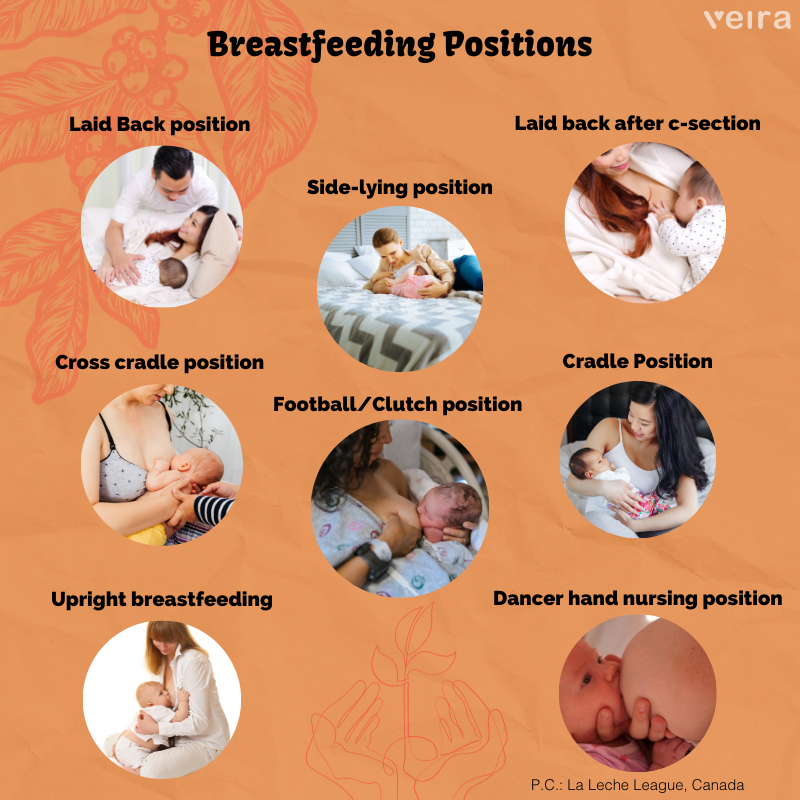Introduction
Every mother’s journey into breastfeeding is as unique as her fingerprint, weaving a bond that’s irreplaceable and intimate. Yet, amidst these heartwarming moments, challenges like finding the ideal nursing position can arise. The position a mother chooses can be the difference between a comfortable, effective feeding or a frustrating experience for both mother and baby.
Breastfeeding is a nurturing experience for both mother and child. Some nursing positions and breastfeeding holds can work better than others for you and your baby. From football hold to cradle hold and laid-back, there are several breastfeeding positions nursing moms can experiment with to find what works for them and their baby.
To make breastfeeding comfortable and effective, here are some of the positions to try. Remember, the most crucial thing is your own comfort and for the baby to be able to feed well. Through experimentation and a touch of patience, mothers can discover which positions bring out the best feeding experiences for them and their baby.
The Importance of Proper Breastfeeding Positioning
Finding the right breastfeeding position is more than a comfort factor – it can influence the baby’s latch, milk supply, and overall health of both mother and baby. It plays a vital role in promoting successful and enjoyable breastfeeding, contributing to the overall health and well-being of both mother and child.
Optimal Latch: The right position ensures that the baby can latch onto the breast properly. A good latch is essential for effective milk transfer, which, in turn, supports the baby’s growth and development.
Comfort: Comfort is essential for both the mother and the baby. A proper breastfeeding position reduces the risk of discomfort, pain, and sore nipples for the mother. It also allows the baby to feed comfortably, reducing the likelihood of frustration during feeding.
Milk Supply: The right position enables good latching and effective feeding. When the baby latches well and feeds effectively, it signals to the body to produce an adequate milk supply to meet the baby’s needs.
Bonding: Breastfeeding is not just about nourishment; it’s also an opportunity for bonding between the mother and baby. Finding the right position can enhance this bonding experience by allowing for eye contact, skin-to-skin contact, and physical closeness.
Feeding Efficiency: Different positions can be more efficient for different babies. Some positions may be more suitable for babies with certain feeding challenges, such as shallow latch or reflux. Finding the right position can improve feeding efficiency and reduce the risk of excessive air ingestion.
Variety and Adaptability: Having knowledge of various breastfeeding positions provides flexibility. Babies may have preferences for certain positions, and some positions may be more comfortable or practical in different situations, such as in public or during nighttime feedings.
Maternal Well-Being: A comfortable and effective breastfeeding position can contribute to the overall well-being of the mother. When breastfeeding is more comfortable and less stressful, it can reduce maternal anxiety and postpartum depression.
Support for Special Situations: In cases of twins, premature babies, or babies with specific health conditions, finding the right position can be even more critical. Certain positions may be better suited to accommodate these unique circumstances.
So as you experiment to find the most suitable position, take into account factors such as the baby’s age, your own comfort and preferences, and special circumstances like c-sections or premature births. Every position has its benefits and potential challenges.
Common Breastfeeding Positions
1. Laid Back Position
Ideal for baby-led attachment, particularly for babies with sensitive stomachs or gas. In this stance, mothers semi-recline with the baby resting on their stomach, their head near the breasts. The nursing position is helpful if the baby struggles to latch onto other holds. Use along with skin-to-skin contact which will help in stimulating feeding instincts.
2. Laid Back After C-section
Mothers post C-section can recline with the baby’s body across their shoulder, allowing nursing without pressure on the wound. The side-lying position is another alternative. (See here for our post on breastfeeding after C-section.)
3. Side-Lying Position
Both mother and baby lie side-by-side, facing each other. Mothers can support their breasts with their hands if needed. Ideal for mothers looking for a bit of rest or those recovering from a C-section, the side-lying position allows you and your baby to lie down while breastfeeding. Ideal nursing position for relaxed night feeds and breastfeeding in bed, a side-lying position can be more comfortable than sitting if the mom has had a cesarean or stitches. The side-lying position is also great during the nights when the mother is tired and wants to nurse while lying down.
4. Cradle Position
The baby lies on the same arm as the feeding breast, with their head resting on the mother’s elbow. The cradle hold is one of the most popular positions, particularly for mothers who are getting the hang of breastfeeding. A classic position when thinking of breastfeeding involves the mom sitting upright, with the baby positioned on the side and head and neck lying along the forearm and the baby’s position against the stomach. A very popular position, it is not always easy with a newborn when you are just getting used to nursing. A breastfeeding pillow across the lap will help prop the baby, giving them more support, and avoiding strain on the back or shoulders. When using a breastfeeding pillow, make sure it does not lift the baby too high.
5. Cross Cradle Position
The baby is cradled in the arm opposite the feeding side. The mother’s wrist rests between the baby’s shoulder blades, supporting the head and neck. Similar to the cradle hold, the cross-cradle hold allows for a bit more control and support, especially useful for newborns and younger infants. Similar to the cradle hold, the arms switch roles so that the baby’s body lies along the opposite forearm. With a cross-cradle hold, the aim is to support the baby around the neck and shoulders, allowing them to tilt their head prior to the latch. Considered a great newborn breastfeeding position, it is also good for small babies and those with latching difficulties.
6. Football Hold/Clutch Position
The football hold, sometimes also known as the clutch hold, is an excellent position for mothers who have had a C-section or those nursing multiples or preemies. The baby is placed beside the mother, with their legs under her arm.
7. Upright Breastfeeding/Koala Hold
The baby sits either straddling the mother’s thigh or on her hip, maintaining an upright position as they feed, with their head positioned towards the breast. This position can be particularly useful for babies who have reflux issues, as it can help reduce the likelihood of milk flowing back into the esophagus.
8. Dancer Hand Nursing Position
This position is especially useful for babies who find it hard to latch due to conditions like low muscle tone, Down’s syndrome, disabilities, or illness. Mothers use three fingers to cup their breast, and with their pointer finger and thumb, they support the baby’s head, holding both the breast and baby’s head with one hand.
Common Breastfeeding Positions Every New Mom Should Know –

Tips for Ensuring a Good Latch in Different Positions
Ensuring a good latch is key for successful breastfeeding. It is pivotal in averting sore nipples, bolstering milk supply, and propelling milk production. Making sure that your breastfed baby latches on properly can take a little practice. By trying different breastfeeding holds, you can identify the best positioning that works for your baby, making latching on easier.
Steps to Ensure a Successful Latch:
Positioning: Once you and your baby are comfortably positioned, guide your little one towards the breast to encourage them to latch on correctly.
The C-hold Technique: With your free hand, adopt the C-hold: fingers below the breast and thumb on top. This aids in presenting the nipple effectively. For easier latching, gently compress the breast.
Comfort Is Key: Utilize cushions, pillows, or rolled towels to offer support for your back and arms, ensuring you’re relaxed throughout the session.
Latch Evaluation: Periodically assess your baby’s latch. Remember, a good latch is integral for a pain-free breastfeeding experience.
Characteristics of a Good Latch:
- Foundational: A cornerstone for successful breastfeeding.
- Nutritional Assurance: Guarantees adequate nourishment for the baby.
- Minimized Discomfort: Reduces chances of nipple soreness for the mother.
Signs of Proper Latching:
- Visual:
Mouth: Widely open with a significant part of the areola inside.
Lips: Flanged outwards, not inverted.
Facial Position: Chin in contact with the breast and nose either free or barely touching. - Sensation: More of a gentle tug than a painful pinch.
- Audible: Consistent, rhythmic sucking accompanied by soft and regular swallowing sounds.
- Baby’s Behavior: After feeding, the baby should seem satisfied, may appear drowsy or even drift to sleep. Their sucking pattern should display a regular suck-swallow-breathe rhythm, with cheeks looking full and not sunken.
- Mother’s Experience: Initial latching might bring a slight pull sensation, but overall, the process should be painless. Persistent pain indicates the need for repositioning.
Signs that a Breastfeeding Position is Working
The tell-tale signs of successful feeding can provide reassurance to nursing mothers. Let’s explore these signs in-depth:
- Deep Latch: Your baby should have a deep latch onto the breast. Their mouth should be wide open, with a good portion of the areola (the darker area around the nipple) in their mouth. A shallow latch can lead to nipple pain and ineffective feeding.
- Audible Swallowing: During an effective feed, you should be able to hear your baby swallowing milk. You may hear a rhythmic “swallow, swallow, swallow” sound. Swallowing indicates that your baby is getting milk from the breast.
- Regular Sucking: Your baby should have a pattern of sucking and swallowing during a feed. They may start with rapid sucks to stimulate milk flow (suck-swallow pattern) and then switch to slower, deeper sucks when the milk is flowing.
- Relaxed Jaw and Hands: As your baby feeds, their jaw should move smoothly, and their hands should be relaxed. Tension in the jaw or clenched fists can be signs of an ineffective latch or feeding.
- Contentment: After a feed, your baby should appear content and satisfied. They may release the breast on their own or fall asleep with a relaxed body. A content baby is often a sign of a full feed.
- Diaper Output: Regular wet and dirty diapers are indicators that your baby is getting enough milk. In the first few days, your baby may have meconium stools, but these should transition to yellow, seedy, and loose stools. By the end of the first week, your baby should have at least 6 wet diapers a day.
- Weight Gain: Your baby’s weight should be steadily increasing. Your healthcare provider will monitor your baby’s weight to ensure they are growing appropriately.
- Breast Changes: Your breasts should feel softer after a feed, indicating that your baby has effectively removed milk. Engorgement or consistently firm breasts can be a sign of inadequate milk removal.
- Feeding Frequency: Newborns typically feed 8-12 times a day during the first few weeks. Frequent, on-demand feeding is essential to establish and maintain your milk supply.
- Breast Comfort: While some nipple tenderness is common in the early days, breastfeeding should not be consistently painful. If you experience severe pain, cracked nipples, or bleeding, it may indicate an issue with the latch that needs correction.
When to Seek Help
While breastfeeding is a natural process, challenges can arise. Recognizing the need for support and professional assistance is vital for a successful breastfeeding journey. If you notice any signs that concern you, or if you have doubts about the effectiveness of breastfeeding, it’s important to seek help and support from a doula, lactation consultant or healthcare provider. They can assess the situation and provide guidance to ensure successful breastfeeding for you and your baby.
- Pain: If consistent discomfort persists after feedings, consult a professional.
- Latch Issues: Continuous latching problems may need expert attention.
- Engorgement or Mastitis: Swollen or inflamed breasts should be checked.
- Weight Concerns: If a baby’s weight gain seems off, it’s time to seek advice.
- Blocked Ducts: Noticeable lumps in the breast? Get them reviewed.
- Milk Supply: Concerns about milk quantity benefit from expert strategies.
If faced with these challenges, reach out to healthcare professionals or lactation consultants promptly.
Conclusion
How Veira Life Can Enhance Your Breastfeeding Journey
The challenges and joys of breastfeeding are unique to every mother. At Veira Life, we understand this journey and strive to be your pillar of support. Our lactation consultants and certified experts are trained to address any concerns, from latching issues to milk supply. With Veira Life, not only do you get expert advice, but a compassionate partner to guide you. Whether it’s your first latch or navigating feeding in public, our dedicated Veira Coaches are here to guide, counsel, and ensure a smooth breastfeeding journey. Embrace motherhood confidently with Veira by your side. Dive deep into our supportive ecosystem – Register now and let us be part of your beautiful journey.
FAQs
The four most commonly used breastfeeding positions include-
- Cradle hold
- Cross-cradle hold
- Clutch or football hold
- Side-lying position
Breastfeeding is a highly personal experience, and the best position for a mother can vary depending on her comfort, her baby’s latch, and any specific breastfeeding challenges they may face. It’s important to find the position that works best for both you and your baby.
Yes, many mothers find it comfortable, especially at night. Initially, other positions might be easier. When lying down, both mother and baby face each other. Using pillows for support helps. Ensure the baby’s ear, shoulder, and hip are aligned for easier feeding. Practice during the day when you are both fully awake..
As per reports issued by the American Academy of Pediatrics as well as the World Health Organization, it is recommended to breastfeed for the first 6 months, with continued breastfeeding while introducing the baby to appropriate complementary foods thereafter.
During the initial week, many full-term babies take no more than 30 to 60 ml at feedings, as newborns’ stomachs are small. After 4 to 5 weeks, babies are likely to reach their peak feeding volume of about 90 to 120ml. The peak daily milk intake is about 900ml. All these amounts can vary depending on various factors such as growth rate, appetite, and feeding frequency.
If the baby is healthy, gaining proper weight, and seems content after most breastfeeds, they are getting just the right amount of what they need. Babies can take anywhere between 5 minutes and 40 minutes at each feed.







